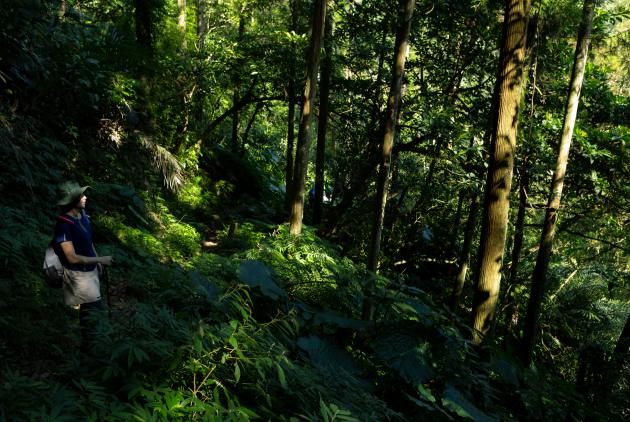Discover the Danlan Old Trails
Taiwan’s Pilgrimage of Nature

Source:Justin Wu
Hidden in the mountains in northeastern Taiwan are the remnants of some of the earliest trade routes connecting the Taipei basin with Yilan County. The system of trails showcases diverse landscapes, a sense of adventure and distinct glimpses at the past, and the chance to enjoy the charming town of Shuangxi on the way home.
Views
Taiwan’s Pilgrimage of Nature
By Monica WangFrom CommonWealth Magazine (vol. 665 )
The Tamsui-Kavalan Historical and Cultural Trails (now dubbed the “Danlan Old Trail” system) were the main arteries connecting the Tamsui sub-prefecture (the Taipei basin) and Kavalan (Yilan) during the Qing dynasty more than 200 years ago. A northern official route, a central people’s route and a southern tea route were carved through the mountains because of the large resettlement of people toward Yilan’s Lanyang Plain.
These routes once harbored peoples’ dreams of a peaceful and prosperous existence, but with the arrival of the modern era, they were eventually replaced by railways and public roads.
But they have been revived, at least in part, through a four-year project undertaken by the Taiwan Thousand Miles Trail Association (TMI Trail, 台灣千里步道協會) and the New Taipei Tourism and Travel Department, as the “Danlan Old Trail” (淡蘭古道). The northern route was completely renovated and opened to visitors.
 Photo by Justin Wu/CW
Photo by Justin Wu/CW
A prime example of a national-level green trail, the Danlan Old Trail offers spellbinding mountain and ocean scenery and historical landscapes and could evolve into an international “pilgrimage route” (similar to the Camino de Santiago or Way of St. James in Spain, a UNESCO World Heritage Site) seen as a place everybody should visit at least once in their lifetime.
In September 2018, a promotional film about the Danlan Old Trail was selected to be screened at the inaugural World Trails Conference World Trails Film Festival.
Another hiker’s paradise, the Beishi River Historical Trail (北勢溪古道) on the central route of the Danlan Old Trail system, closely follows the upper reaches of the Beishi River. More than any other rehabilitated trail, it preserves the original terrain of the old route and a diverse array of landscapes while remaining very accessible and providing a sense of adventure.
A map of the central route of Danlan Trail shows it starting at Nuannuan within the city limits of Keelung and then proceeds through parts of New Taipei including Shifen, Ganjiao and Taiping in Shuangxi, and Sanshuitan and Wantan in Pinglin, before reaching Waiao in Yilan County.
The section between Sanshuitan and Taiping alone covers about 5.6 kilometers and requires a roughly three-hour trek.

Unlike other trails hugging the upstream parts of rivers in Taiwan’s mountains that can be steep and hard to navigate, the mountain trails along the Beishi River – the source of the Feitsui Reservoir – are more undulating. Though there are many of them, they are easy to follow and a joy to walk, traversing or passing by small natural pools, waterfalls and the crystal clear river. On clear days when the sun is shining, reflections of the trail’s vegetation in the ponds pop with stunning clarity.
 Photo by Sara Wu/CW
Photo by Sara Wu/CW
The Beishi River Historical Trail winds through a dense forest that protects hikers from the scorching sun, but it is not without peril – the stony sections of the path covered in moss can be treacherously slippery because of the frequent rain in the area.
Though the trails retain some of their original flavor, tasteful human touches are in evidence – stepped trails, bridges made of Chinese fir and drainage systems tailored to fit seamlessly in the natural environment using local materials. In fact, that was the mission of the Danlan Old Trail’s overhaul.

Photo by Justin Wu/CW
Those touches were so minimalist and so effortlessly blended into their natural settings that some people complained about the apparent lack of work done on the trail and wondered where the government’s money went, according to Lai Chia-feng (賴嘉豐), an official with the New Taipei Tourism and Travel Department.
Having the trail appear so natural was in fact the government’s goal, Lai said, hoping that future projects will also not interfere with nature.
Reclaiming Memories of Ancestors
Beyond the trail’s natural splendor, the small, somewhat inconspicuous earth god shrines lining the route are also a major draw.
“In contrast with the northern official route that was laid out, widened and flattened by the authorities, the central route was developed by private citizens, and you can experience how our ancestors endured great hardships to blaze the trail through these mountains,” said Chen Jian-fang (陳靜芳), a senior executive officer with New Taipei’s travel bureau who has been an advocate for these trails for many years.
A few years ago, architect Liu Shen-tzong (劉憲宗) teamed up with hiking clubs on a survey of small earth god shrines in New Taipei and found that of the roughly 1,000 existing around Taiwan, there were 250 on the Danlan Trail alone, with 82 of them in Shuangxi. Liu believes the high number reflects the frequency with which the early settlers used these routes.
Photo by Sara Wu/CW
Before one even starts on the Beishi River Historical Trial, a century-old earth god shrine appears along the river near Fude Temple, reflecting the beliefs and faith of the early pioneers as they opened these new transportation arteries.
Rare Plants from the Jurassic Age
When hikers enter the trail at Liujiaokeng (料角坑), they should be on the lookout for a survivor of the natural world and the signature plant of the Tamsui - Kavalan Trail – the “coupled dipteris,” sometimes dubbed the “parasol fern,” that dates back to the Jurassic Age. These bifurcated “relict” plants were far more common 200 to 400 million years ago, but now only exist in a few Asian countries, including Taiwan.
 Photo by Justin Wu/CW
Photo by Justin Wu/CW
A Feast of Organic Wild Vegetables
Visiting the small villages in the area is another important part of the experience. Once you’ve walked the Beishi River Historical Trail, you can drive or take bus F815 to the nearby Shoushan Temple in Taiping. This seemingly sparsely populated area is in fact located on the popular Hubaotan Trail, and farmers often congregate there to sell vegetables such as wild greens and mushrooms to hikers.
Experiencing the Pleasures of a Mountain Village
Another option after the hike is to spend some time in the small town of Shuangxi, the main hub of the Danlan Old Trail system. Surrounded by mountains, the town was once described by writer Lin Heng-dao (林衡道) as a “Venice in the mountains” because of the converging Pinglin and Mudan rivers and its natural charm and rich historical past.
The director of the New Taipei Green Life Association, Sandia Chien (簡淑慧), has bet on the area by returning to her hometown to promote tourism there, believing in the importance of having cultural initiatives take root in their communities.
Standing in front of the old wharf area, Chien paints a vivid picture of how lively Shuangxi was around the time Canadian missionary George Leslie Mackay arrived in Taiwan in 1871 to the 1950s when it was a thriving coal mining town with stores, movie theaters and drinking clubs.
“In the 1920s, the water level was around three stories high and big sailboats could sail in,” Chien said.
Today, once-bustling Changan Street is very quiet, expect for the century-old Linyihe traditional Chinese medicine shop. The fourth-generation owner Lin Hsien-yang (林顯揚) enthusiastically guides visitors around the Western-style mansion built in 1874. A spin around the wharf area, the Chou family mansion and a few special buildings on the old street takes around an hour.

Taking a Break at a Unique Coffee Shop
Walking back toward the train station, along the banks of the Mudan River, one passes by a small but fascinating coffee shop – the Silou Café – that serves fresh brewed coffee, food with a creative twist and kiln-baked bread. The owner, Wu Su-mei (吳素鎂), had planned to return to her family home in Gongliao and live off the land after retiring from her teaching career, but her discovery of this shop seemed part of her destiny. She has imbued her shop with many of her favorite aesthetics and converted the second floor into a cultural space where she organizes cultural activities, including talks on brewing coffee.

Photo by Justin Wu/CW
It is a great place in which to cap off a day in the mountains, for there is nothing more comforting than relaxing in a welcoming coffee shop and savoring the day’s journey with travel companions.
 Photo by Justin Wu/CW
Photo by Justin Wu/CW
【Suggested Routes】
Beishi River Historical Trail (Central Route)
Liaojiaokeng, Shuangxi District → Sanshuitan, Pinglin District
The trail features
- By car: National freeway No. 5 → Shiding exit → County Highway No. 106 → Provincial Highway 2C (2丙) → Shuangtai Industry Road → Hubaotan → Shoushan Temple → Residence with the address No. 17, Liaojiaokeng
- By public transportation: New Taipei public bus F815 between Shuangxi and Wantan; get on at the Shuangxi Train Station and get off at the “Liaojiaokeng” stop
- Nearby trails: Wantan Old Trail, Baozichu Old Trail, Kuolai Old Trail, Wushan Old Trail
- Notes: There are many stones on the trail, and the moss on them can get slippery
- Other Route: Danlan Old Trail (Northern Route)
- Northern Taiwan’s first east-west traffic artery – the Danlan Old Trail Northern Route (official route); the entire trail has been rehabilitated. We suggest the three historical routes that were developed the earliest – the Canguangliao Old Trail, Yangtingli Old Trail, and the Rulanzheng Old Trail.
Have you read?
♦ The Best Hiking Trails in Taiwan
♦ Taiwan's Global Noah’s Ark of Plants
♦ The Hakka Cultural Renaissance Memories Along a Mountain Route
Translated by Luke Sabatier
Uploaded by Sharon Tseng












